- Clone
- N52A/42 (See other available formats)
- Regulatory Status
- RUO
- Other Names
- Stress-70 protein, mitochondrial, GRP-75, p66 MOT, C3H-specific antigen, heat shock protein 9A, heat shock protein, A, peptide-binding protein 74, heat shock 70 kD protein 9, heat shock protein cognate 74, 74 kD, A, 75 kD glucose-regulated protein
- Previously
-
Covance Catalog# MMS-5164
- Isotype
- Mouse IgG1, κ
- Ave. Rating
- Submit a Review
- Product Citations
- publications
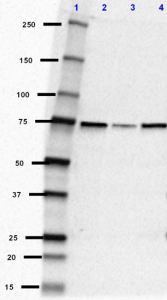
-

Western blot of purified anti-Grp75 (Mortalin) antibody (clone N52A/42). Lane 1: Molecular weight marker; Lane 2: 20 µg of human brain membrane lysate; Lane 3: 20 µg of mouse brain membrane lysate; Lane 4: 20 µg of rat brain membrane lysate. The blot was incubated with 5 µg/mL of the primary antibodies overnight at 4°C, followed by incubation with HRP labeled goat anti-mouse IgG (Cat. No. 405301). Enhanced chemiluminescence was used as the detection system. -

IHC staining of purified anti-Grp75 (Mortalin) antibody (clone N52A/42) on formalin-fixed paraffin-embedded mouse brain tissue. Following antigen retrieval using Sodium Citrate H.I.E.R (Cat. No. 928602), the tissue was incubated with 10 µg/ml of the primary antibody overnight at 4°C. BioLegend´s Ultra-Streptavidin (USA) HRP kit (Multi-Species, DAB, Cat. No. 929901) was used for detection followed by hematoxylin counterstaining, according to the protocol provided. The image was captured with a 40X objective. Scale bar: 50 µm -

IHC staining of purified anti-Grp75 (Mortalin) antibody (clone N52A/42) on formalin-fixed paraffin-embedded rat brain tissue. Following antigen retrieval using Sodium Citrate H.I.E.R (Cat. No. 928602), the tissue was incubated with 10 µg/ml of the primary antibody overnight at 4°C. BioLegend´s Ultra-Streptavidin (USA) HRP kit (Multi-Species, DAB, Cat. No. 929901) was used for detection followed by hematoxylin counterstaining, according to the protocol provided. The image was captured with a 40X objective. Scale bar: 50 µm -

IHC staining of purified anti-Grp75 (Mortalin) antibody (clone N52A/42) on formalin-fixed paraffin-embedded human brain tissue. Following antigen retrieval using Sodium Citrate H.I.E.R (Cat. No. 928602), the tissue was incubated with 10 µg/ml of the primary antibody overnight at 4°C. BioLegend´s Ultra-Streptavidin (USA) HRP kit (Multi-Species, DAB, Cat. No. 929901) was used for detection followed by hematoxylin counterstaining, according to the protocol provided. The image was captured with a 40X objective. Scale bar: 50 µm -

IHC staining of purified anti-Grp75 (Mortalin) antibody (clone N52A/42) on formalin-fixed paraffin-embedded rat brain tissue. Following antigen retrieval using Sodium Citrate H.I.E.R (Cat. No. 928602), the tissue was incubated with 10 µg/ml of the primary antibody overnight at 4°C. BioLegend´s Ultra-Streptavidin (USA) HRP kit (Multi-Species, DAB, Cat. No. 929901) was used for detection followed by hematoxylin counterstaining, according to the protocol provided. The image was captured with a 40X objective. -

Western blot of purified anti-Grp75 (Mortalin) antibody (N52A/42). Lane 1: Molecular weight marker; Lane 2: 20 µg of Drosophila head lysate; Lane 3: 20 µg of Drosophila S2 (embryonic) cell lysate. The blot was incubated with 0.5 µg/mL of the primary antibody overnight at 4°C, followed by incubation with HRP-labeled goat anti-mouse IgG (Cat. No. 436302). Enhanced chemiluminescence was used as the detection system.
| Cat # | Size | Price | Quantity Check Availability | Save | ||
|---|---|---|---|---|---|---|
| 818802 | 25 µL | £57 | ||||
| 818801 | 100 µL | £113 | ||||
Glucose-regulated protein, 75 kD (Grp75), also known as heat shock protein 9A, Stress-70 protein, p66 MOT, and Mortalin, is an ubiquitously expressed chaperone protein that is expressed predominantly in mitochondria and is involved in mitochondrial localization, intracellular trafficking, and receptor internalization.
Product DetailsProduct Details
- Verified Reactivity
- Human, Mouse, Rat, Drosophila
- Antibody Type
- Monoclonal
- Host Species
- Mouse
- Immunogen
- This monoclonal antibody was raised against a fusion protein corresponding to amino acids 551-766 of mouse SALM2.
- Formulation
- Phosphate-buffered solution.
- Preparation
- The antibody was purified by affinity chromatography.
- Concentration
- 1 mg/ml
- Storage & Handling
- The antibody solution should be stored undiluted between 2°C and 8°C. Please note the storage condition for this antibody has been changed from -20°C to between 2°C and 8°C. You can also check your vial or your CoA to find the most accurate storage condition for this antibody.
- Application
-
WB - Quality tested
IHC-P - Verified - Recommended Usage
-
Each lot of this antibody is quality control tested by Western blotting. For Western blotting, the suggested use of this reagent is 0.5 - 10 µg per ml. For immunohistochemistry on formalin-fixed paraffin-embedded, a concentration of 10.0 µg/ml is suggested. It is recommended that the reagent be titrated for optimal performance for each application.
- Application Notes
-
Reactivity to Drosophila was only verified with the purified format.
- Additional Product Notes
-
For Western blotting, the suggested use of this reagent is 1 - 5 µg/ml in human, mouse, and rat and 0.5 - 10 µg/ml in Drosophila.
- Product Citations
-
- RRID
-
AB_2783394 (BioLegend Cat. No. 818802)
AB_2564824 (BioLegend Cat. No. 818801)
Antigen Details
- Structure
- Expected MW: 70 kD
- Biology Area
- Cell Biology, Mitochondrial Function, Neuroscience, Neuroscience Cell Markers
- Molecular Family
- Mitochondrial Markers
- Gene ID
- 15526 View all products for this Gene ID
- UniProt
- View information about Grp75 on UniProt.org
Related Pages & Pathways
Pages
Related FAQs
Other Formats
View All Grp75 (Mortalin) Reagents Request Custom Conjugation| Description | Clone | Applications |
|---|---|---|
| Purified anti-Grp75 (Mortalin) | N52A/42 | WB,IHC-P |
| HRP anti-Grp75 (Mortalin) | N52A/42 | WB |
Compare Data Across All Formats
This data display is provided for general comparisons between formats.
Your actual data may vary due to variations in samples, target cells, instruments and their settings, staining conditions, and other factors.
If you need assistance with selecting the best format contact our expert technical support team.
-
Purified anti-Grp75 (Mortalin)

Western blot of purified anti-Grp75 (Mortalin) antibody (clo... 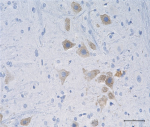
IHC staining of purified anti-Grp75 (Mortalin) antibody (clo... 
IHC staining of purified anti-Grp75 (Mortalin) antibody (clo... 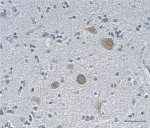
IHC staining of purified anti-Grp75 (Mortalin) antibody (clo... 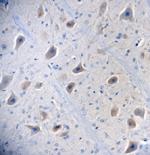
IHC staining of purified anti-Grp75 (Mortalin) antibody (clo... 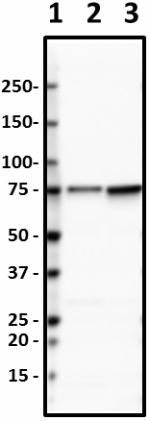
Western blot of purified anti-Grp75 (Mortalin) antibody (N52... -
HRP anti-Grp75 (Mortalin)
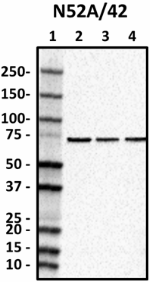
Western blot of HRP anti-GRP75 (Mortalin) antibody (clone N5...
 Login / Register
Login / Register 












Follow Us